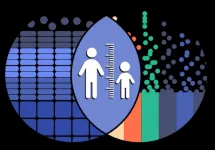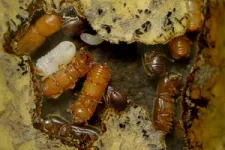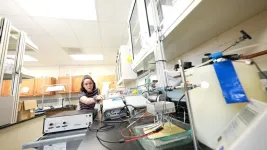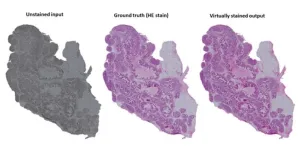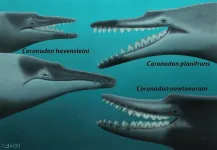Scientists narrow down pool of potential height genes
2023-04-14
(Press-News.org) When it comes to height, our fate is sealed along with our growth plates—cartilage near the ends of bones that hardens as a child develops. Research publishing April 14 in the journal Cell Genomics shows that cells in these plates determine the length and shape of our bones and can hint at our stature. The study identified potential "height genes" and found that genetic changes affecting cartilage cell maturation may strongly influence adult height.
"The study is really understanding the genetics of skeleton," says senior author Nora Renthal (@noradrenal) of Boston Children's Hospital and Harvard University. As a pediatric endocrinologist who cares for children with skeletal diseases, she is interested in understanding how bones grow. "Height is a good starting point to understand the relationship between genes, growth plates, and skeletal growth because we can measure the height of every human being."
To pinpoint height-associated genes, the team screened 600 million mouse cartilage cells to identify genes that, when deleted, can alter cell growth and maturation. These types of cellular changes in the growth plate are known to lead to variations in human height. The search turned up 145 genes mostly linked to skeletal disorders and are crucial for growth plate maturation and bone formation.
The team then compared the discovered genes with data from genome-wide association studies (GWAS) of human height. GWAS allows researchers to survey the entire human genome to identify hotspots where "height genes" are located in our DNA. But these regions can contain multiple genes, making it hard for researchers to track down and study an individual target.
"That's kind of like looking for your friend's house, but you only know the zip code," says Renthal. "It's difficult."
The comparison revealed that genes affecting cartilage cells overlap with hotspots from human height GWAS, precisely locating genes in our DNA that likely play a role in determining our stature. Renthal and her team also discovered that many of the GWAS suggested height genes led to early maturation in cartilage cells. These findings suggest that genetic changes affecting cartilage cell maturation may influence height more.
Renthal notes that studies in mouse cells may not fully translate to humans, and GWAS are observational studies that cannot fully illustrate the cause and effects of height. But her study provides a novel method to bridge the two methods and provide new insights into human genetics.
Next, the team plans to use the method to understand hormones' effect on cartilage cells. They will also look into some of the 145 genes that have no known connection to skeletal growth. The investigation may reveal new genes and pathways that play a role in the bones.
"I see patients with skeletal dysplasia, where there isn't any treatment because genetics made their bones grow this way," says Renthal. "It's my hope that the more we can understand about the biology of the growth plate, the more we would be able to intervene at earlier times in growing skeletons and the life of a kid."
###
Cell Genomics, Baronas et al. “Genome-wide CRISPR screening of chondrocyte maturation newly implicates genes in skeletal growth and height-associated GWAS loci” https://www.cell.com/cell-genomics/fulltext/S2666-979X(23)00065-4
Cell Genomics (@CellGenomics), is a new Gold open access journal from Cell Press publishing multidisciplinary research at the forefront of genetics and genomics. The journal aims to bring together diverse communities to advance genomics and its impact on biomedical science, precision medicine, and global and ecological health. Visit https://www.cell.com/cell-genomics/home. To receive Cell Press media alerts, please contact press@cell.com.
END
ELSE PRESS RELEASES FROM THIS DATE:
2023-04-14
Associate Professor Jonathan Boreyko leads a team at Virginia Tech that has built a strong portfolio of work with ice and water, exploring the possibilities for de-icing planes, building novel water harvesting devices, and creating snow globes out of bubbles. This familiarity with water has given the team a strong sense of its behavior in different states, leading to a new project that shows how ice quenches heat in comparison to water. The findings were published in Chem on April 14.
Mojtaba Edalatpour and master’s student Camryn ...
2023-04-14
Chronic conditions such as type 2 diabetes, asthma, HIV infection, and mental illness may be greatly undertreated in the U.S. jail and prison population, suggests a new study from researchers at the Johns Hopkins Bloomberg School of Public Health.
For their analysis, the researchers used national health survey data covering 2018 to 2020 to estimate rates of chronic conditions among recently incarcerated people, and a commercial prescription database to estimate the distribution of medication treatments to the jail and prison population. Their analysis suggests ...
2023-04-14
About The Study: In a study of matched pairs of counties that reopened with in-person versus virtual instruction at the secondary school level in the 2020 to 2021 academic year, counties with in-person school instructional models early in the COVID-19 pandemic experienced increases in county-level COVID-19 incidence at six and eight weeks after in-person reopening, compared with counties with virtual instructional models.
Authors: Meredith Matone, Dr.P.H., of Children’s Hospital of Philadelphia, is the corresponding author.
To access the embargoed study: Visit our For The ...
2023-04-14
About The Study: The findings of this study of survival outcomes for 1,618 U.S. counties suggest that greater representation of Black primary care physicians (PCPs) in the PCP workforce is associated with improved survival-related outcomes for Black individuals, although there was a dearth of U.S. counties with at least one Black PCP during each study time point. Investments to build a more representative PCP workforce nationally may be important for improving population health.
Authors: John E. Snyder, M.D., M.S., M.P.H., and Rachel D. Upton, Ph.D., of the U.S. Department of Health and Human Services in Rockville, Maryland, are the corresponding ...
2023-04-14
About The Study: In this study of 81,755 Medical College Admission Test examinees, American Indian or Alaska Native, Black, and Hispanic students reported lower parental educational levels, greater educational and financial barriers, and greater discouragement from pre-health advisers than white students. These barriers may deter groups underrepresented in medicine from applying to and matriculating at medical school.
Authors: Jessica Faiz, M.D., M.S.H.P.M., of the Veterans Affairs Greater Los Angeles Healthcare System and UCLA in Los Angeles, is the corresponding ...
2023-04-14
Artificial Intelligence (AI) experts have been challenged to help a new space mission to investigate Earth’s place in the universe.
The Ariel Data Challenge 2023, which launches on 14 April, is inviting AI and machine learning experts from industry and academia to help astronomers understand planets outside our solar system, known as exoplanets.
Dr Ingo Waldmann, Associate Professor in Astrophysics, UCL (University College London) and Ariel Data Challenge lead said:
“AI has revolutionised many fields of science and industry in the past years. The field of exoplanets has fully arrived in the era of big-data and cutting edge AI is needed to break ...
2023-04-14
The researchers of the FinEst Centre for Smart Cities of Tallinn University of Technology (Estonia, Europe) developed the DigiAudit platform to monitor and analyse energy use and indoor climate indicators of buildings and large real estate portfolios in real time. Thinnect, an Estonian IoT start-up company, will help sell the solution and market it worldwide.
We can only reach zero-emission buildings when we have reliable data
The European Union has set a target for all buildings to be zero-emission, or near-zero energy, by 2050. However, there is no reliable data on the energy consumption of many buildings, so it is not possible to monitor the condition ...
2023-04-14
Researchers from the University of Eastern Finland, the University of Turku, and Tampere University have developed an artificial intelligence-based method for virtual staining of histopathological tissue samples as a part of the Nordic ABCAP consortium. Chemical staining has been the cornerstone of studying histopathology for more than a century and is widely applied in, for example, cancer diagnostics.
“Chemical staining makes the morphology of the almost transparent, low-contrast tissue sections visible. Without it, analysing tissue morphology is almost impossible for human vision. Chemical staining is irreversible, and in most ...
2023-04-14
Québec City, April 14, 2023 - Fuchs' endothelial corneal dystrophy, a degenerative eye disease, causes progressive vision loss that can induce blindness. It is the leading cause of corneal transplantation, but the scarcity of grafts hinders its treatment. A research team from Université Laval and Université de Montréal has identified a way to slow the disease and even avoid transplantation if diagnosed at an early stage.
In people with the disease, the endothelial cells at the back of the cornea die more quickly than in healthy people. "Everyone loses them at a slow rate, slow enough to make it to the end of our lives ...
2023-04-14
A new study published in the journal PeerJ by Robert W. Boessenecker (CofC), Brian L. Beatty (NYIT), and Jonathan H. Geisler (NYIT) reports a wealth of new fossils of the early toothed baleen whale Coronodon from Oligocene (23-30 million years old) rock layers near Charleston, South Carolina. These include five new skulls, representing two new species: Coronodon planifrons and Coronodon newtonorum, and young juveniles of Coronodon havensteini – first named from a single skull by this team in 2017. Coronodon is one of the most primitive members ...
LAST 30 PRESS RELEASES:
[Press-News.org] Scientists narrow down pool of potential height genes
